
Santiago de Cali, or Cali, is the capital of the Valle del Cauca department, and the most populous city in southwest Colombia, with 2,227,642 residents according to the 2018 census. The city spans 560.3 km2 (216.3 sq mi) with 120.9 km2 (46.7 sq mi) of urban area, making Cali the second-largest city in the country by area and the third most populous after Bogota and Medellin. As the only major Colombian city with access to the Pacific Coast, Cali is the main urban and economic center in the south of the country, and has one of Colombia's fastest-growing economies. The city was founded on 25 July 1536 by the Spanish explorer Sebastian Belalcazar.
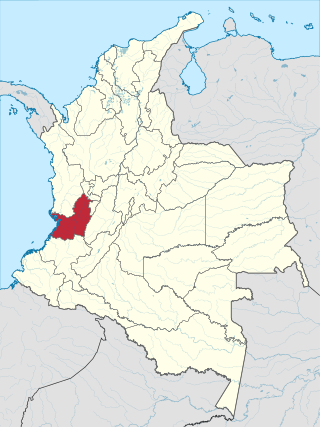
Valle del Cauca, or Cauca Valley, is a department in western Colombia abutting the Pacific Ocean. Its capital is Santiago de Cali. Other cities such as Buenaventura, Buga, Cartago, Palmira and Tuluá have great economical, political, social and cultural influence on the department's life. Valle del Cauca has the largest number of independent towns with over 100,000 inhabitants in the country, counting six within its borders. Buenaventura has the largest and busiest seaport in Colombia, moving about 8,500,000 tons of merchandise annually.
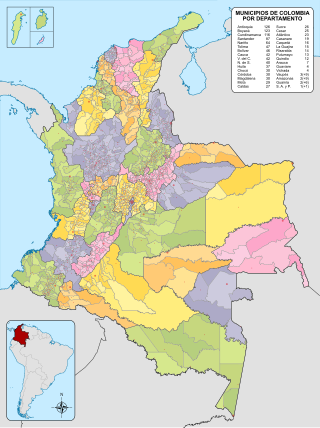
The Municipalities of Colombia are decentralized subdivisions of the Republic of Colombia. Municipalities make up most of the departments of Colombia with 1,122 municipalities (municipios). Each one of them is led by a mayor (alcalde) elected by popular vote and represents the maximum executive government official at a municipality level under the mandate of the governor of their department which is a representative of all municipalities in the department; municipalities are grouped to form departments.
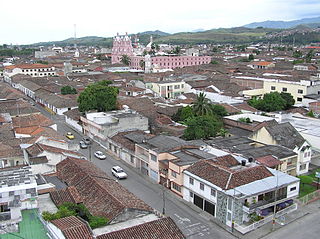
Buga, formally Guadalajara de Buga, is a city and municipality in the Valle del Cauca Department of Colombia. It is famous for its Basilica del Señor de los Milagros, which houses an image of Christ called el Señor de los Milagros.

The Cordillera Occidental is the lowest in elevation of the three branches of the Colombian Andes. The average altitude is 2,000 m (6,600 ft) and the highest peak is Cerro Tatamá at 4,100 m (13,500 ft). The range extends from south to north dividing from the Colombian Massif in Nariño Department, passes north through Cauca, Valle del Cauca, Risaralda, Chocó, and Caldas Departments to the Paramillo Massif in Antioquia and Córdoba Departments. From this massif the range divides further to form the Serranías de Ayapel, San Jerónimo and Abibe. Only to recede into the Caribbean plain and the Sinú River valley.

Calima Lake is the largest artificial lake in Colombia and in the American continent with an area of 70 km2. It is located in the municipality of Darién in the Valle del Cauca Department.

Buenaventura is a coastal seaport city located in the Pacific Region of the department of Valle del Cauca, Colombia. Buenaventura is the main port of Colombia in the Pacific Ocean.

La Cumbre is a town and municipality in Colombia, northwest of Cali, in the Valle del Cauca Department. It is located in the West Andes above the city of Yumbo.

El Cerrito is a town and municipality located in the Department of Valle del Cauca, Colombia. This is one of the 42 municipalities of the department.
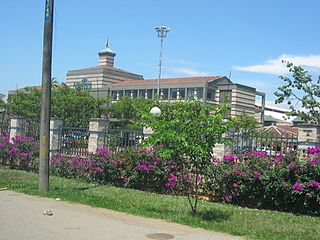
Jamundí is a city and municipality in the Department of Valle del Cauca, Colombia.

The multicoloured tanager is a species of bird in the family Thraupidae. It is endemic to the mountains of Colombia, and as of 2010 has been categorized as vulnerable (VU) by the IUCN.
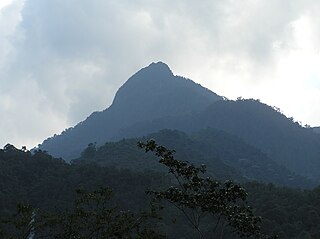
Farallones de Cali is a cluster of mountains in the West Andes of Colombia. It is located west of the city of Cali and gives rise to many of the rivers that provide water and electricity to Cali. The PNN Farallones de Cali encompasses 150,000 ha (580 sq mi) in the mountains as well as much of the Pacific slope and is an area of very high biodiversity. The average temperature ranges from 25 °C (77 °F) in the tropical foothills to 5 °C (41 °F) in the páramo. In this territory are located the district of Pichinde, Andes and Leonera, and two villages Penas Blancas and Lomas de la Cajita.
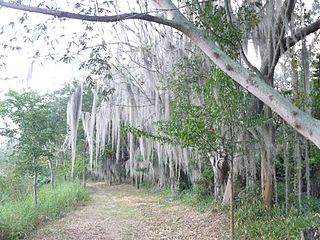
The Laguna de Sonso Nature Reserve is located in the Valle del Cauca Department of Colombia. It contains the last extensive remnant of original natural wetland remaining in the Cauca River Valley in western Colombia, and was declared a nature reserve in October 1978. It comprises a series of marshes and lagoons on the east bank of the Cauca River, between the municipalities of Buga, Yotoco and Guacari. It has an area of 2,045 ha (7.90 sq mi), lying at an altitude of 935 m (3,068 ft). The wetlands are affected by the introduced water hyacinth. The reserve has been designated as a protected Ramsar site since 2017.

Cauca State was one of the states of Colombia.

Calima culture is a series of pre-Columbian cultures from the Valle del Cauca in Colombia.

Cauca culture is a pre-Columbian culture from the Valle del Cauca in Colombia, named for the Cauca River. Middle Cauca culture dates from the 9 to 10th centuries CE.
El Queremal is a town in the Dagua municipality, Valle del Cauca Department, Colombia. It is located about 47 km (29 mi) west of Cali and is at an elevation of 1,450 m (4,760 ft). The town is situated on the upper part of the Old Cali-Buenaventura Road and is about 99 km (62 mi) from Buenaventura, the main Colombian port on the Pacific. The town is accessible from Cali from several roads leading away from the main Cali-Buenaventura Road near the area of Kilometer 18, Valle del Cauca.

Marianne Vere Cardale de Schrimpff is a Colombian anthropologist, archaeologist, academic and writer.

The Calima Gold Museum is an archaeological museum dedicated to the Calima culture located in the historic center of Santiago de Cali, Colombia. The Calima Gold Museum was the ninth museum created by the Bank of the Republic of Colombia in order to show the artistic and cultural expressions of the pre-Hispanic populations. It is also one of the Bank's six gold museums located throughout Colombia, their main one being the Gold Museum in Bogotá.
Bajo Calima is a village in Buenaventura Municipality, Valle del Cauca Department in Colombia.



















